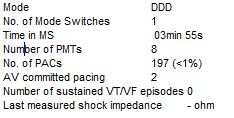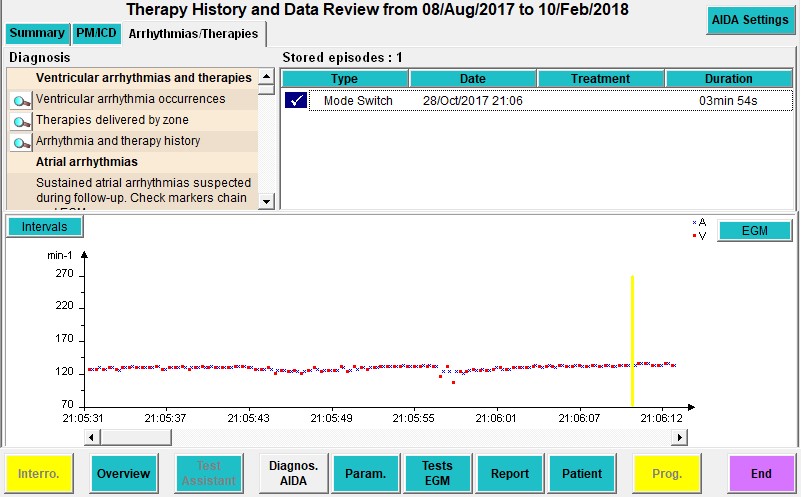Exercise (2)
Case Summary
0 of 2 Questions completed
Questions:
Information
You have already completed the case before. Hence you can not start it again.
Case is loading…
You must sign in or sign up to start the case.
You must first complete the following:
Results
Results
Time has elapsed
Catégories
- Pas classé 0%
-
The most common reason of loss of CRT during exercise is loss of atrial tracking when the atrial rate becomes faster than the upper tracking rate. While in this case, the atrial rate is flirting with the upper tracking rate (130 bpm = 460 ms), the atrial rate does not exceed this rate and we do not observe As – Vs cycles. In this case, the appearence of Ar markers mean that there is an algorithm at play. Since the rate is at maximal tracking with stable AV (and therefore also stable VA) intervals, the device actually suspects the occurrence of a pacemaker mediated tachycardia (PMT). The details of the anti-PMT are explained here but we can see that the AV-delay is changed. By chance, the next As cycle is a bit slower, which is for the device a confirmation of PMT. As a result, the next atrial sensed event becomes Ar. Ar events are not tracked as to terminate a possible PMT, this is the goal of an anti-PMT algorithm. We then see that the next atrial events are also within the WARAD (<500 ms) and the device performs a mode switch.
This patient had a single inappropriate mode switch episode, only 8 PMTs and 100% CRT so it has no clinical relevance.

While the anti-PMT algorithm does not trigger the registration of the EGM into the memory of the device, a counter is held and shown in the “Statistics” screen.
The incidence of inappropriate anti-PMT algorithm for loss of CRT is not known as the episodes are not saved into the memory of the device (only a counter is shown as the figure shows). For Abbott and Boston Scientific devices these episodes are saved into the memories of the device and we discovered that it is actually a quite common trigger for loss of CRT (J of Electrocardiology 2016)
- 1
- 2
- Current
- Review / Skip
- Answered
- Exact
- Inexact
-
Question 1 of 2
1. Question
A 64-year old lady with dilated cardiomyopathy and left bundle branch block was implanted with a CRT-D (PARADYM SonR, MicroPort).
She is asymptomatic and comes to your outpatient clinic for a regular follow-up. During device check-up you see the following Mode Switch episode.

What is going on?
ExactInexact -
Question 2 of 2
2. Question
ExactInexact


